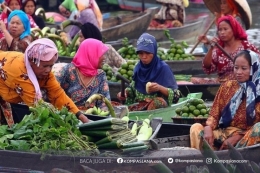The construction of a strong nation that adheres to the noble values of its culture will be able to realize human action with nature in it and be able to provide a full state of life with quality.
We can see things like relics of objects and non-fines of our ancestors to date, such as batik, angklung, reog, silat, keris, kertagama state, etc. That is all when we examine in depth why so many of these ancestral relics, and what does it relate to the foundation of the integrity of the country's progress? Then the writer wants to dissect one by one the meaning of the relic.
Batik in philosophy and hope that since childhood someone already has good values, so that they are respected by the community. While the creation of bamboo music such as Angklung is based on an agrarian Sundanese outlook on life with a source of life from rice (pare) as its staple food.
There are also relics of dances such as Reog traditional dance in an open arena that serves as people's entertainment, contains magical elements, the main dancer is a lion-headed person with a decoration of peacock feathers, plus several masked dancers and lumping riding, and this dance is very much of meaning for life if studied in depth.
Then Silat, the ancestors of the Indonesian people, had a way of self-defense aimed at protecting and defending their lives or groups from the challenges of nature. They create martial arts by imitating the movements of animals in the natural environment, such as movements of apes, tigers, snakes, or eagles.
The origin of martial arts in the archipelago is likely to also develop from the skills of indigenous Indonesian tribes to hunt and fight using machetes, shields and spears, for example as in the Nias tribal tradition which until the 20th century was relatively untouched by outside influences.
Silat is thought to have spread across the archipelago since the 7th century AD, but its origins have not yet been determined with certainty. Major kingdoms, such as Srivijaya and Majapahit, are said to have great warriors who mastered martial arts and could gather warriors whose skills in self-defense could be relied upon.
Silat researcher Donald F. Draeger believes that evidence of martial arts can be seen from various weapons artifacts found from the classical period (Hindu-Buddhist) as well as on relief sculptures containing the attitudes of silat horses in the temples of Prambanan and Borobudur. In his book, Draeger writes that weapons and martial arts are not inseparable, not only in body work, but also in spiritual relations that are closely related to Indonesian culture.
Whereas the Keris which is a legendary legacy, especially in Java, has cultural values inherent in the philosophy of life. "Keris is ageman, it can be interpreted as clothing or clothing. Brojol keris is a symbol out of a problem. Kakawin or Negarakertagama describes the situation in the Majapahit palace during the reign of King Hayam Wuruk, the great king in Java and the Archipelago.
He enthroned from 1350 until 1389 AD, at the height of the Majapahit empire, one of the largest kingdoms that ever existed in the archipelago, the most important part of this text, of course, was to describe the "areas" of the Majapahit kingdom which had to pay tribute. Nagarakretagama is written in the form of Old Javanese kakawin (poetry).
Each kakawin consists of four lines, called on. Each line consists of eight to 24 syllables, called a dimension. This kakawin script consists of 98 poems, divided into two parts, each of which consists of 49 poems. Each poem consists of between one to ten on. Viewed from the point of view, the distribution of these poems has been done very neatly.










